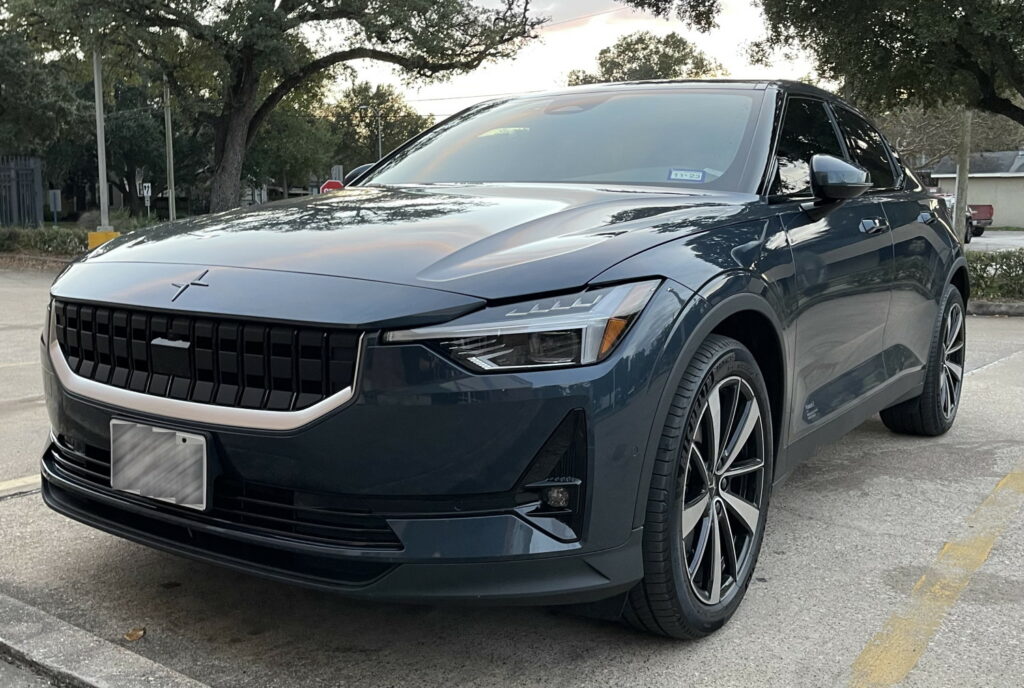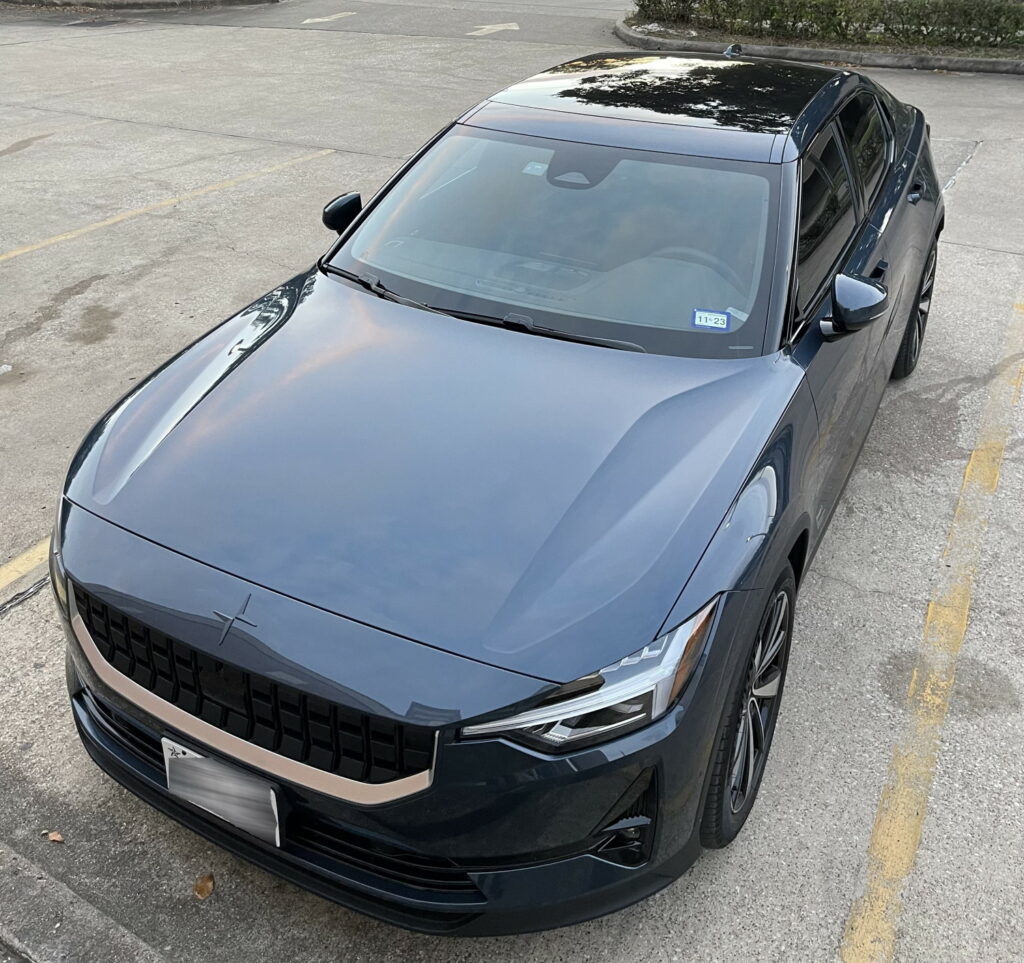Yet Another Entry in the Electric Car series.
It’s easy to write complaints and nitpick stuff that’s clearly wrong. It’s also relatively easy to make that kind or writing funny, enjoyable, or both. It helps me vent as well, which makes it enjoyable to write. Nitpicks and complaints have focal points that anchor the piece. The electronics don’t work. The radios are dead. The engineers are like the Muppets’ Swedish Chef. Børk, børk. børk.
It’s not so easy to write about a smooth experience where things work fine. That’s exactly where I’m at with the Polestar.
Not everything is working fine, but the things that don’t are marginalia, and don’t impact enjoyment. The major missing piece is Phone-as-key (PAK) functionality. I just carry the keyfob around, like everyone else. It’s just as well; at least from what I read online, the PAK functionaliy is buggy enough that relying on it is risky, as in “you might need someone to come pick you up.”
The rest of the experience, now that things are working, melts into the background in the best possible way. What follows is a series of small parts of the experience so far, in the hopes that they’ll provide some gestaltic insight into the whole.
In Houston, the Very Rich People live in River Oaks. They tend to decorate their houses lavishly and professionally for Christmas. The neighborhood looks beautiful. Sightseeing there is a yearly tradition for many local families, mine included. It turned out to be the perfect application for this car. The panoramic roof made the decorated trees easier to see. Gliding around the neighborhood silently made it all the more pleasant, and Google Maps in the dashboard made it a lot easier to get lost in some of the twisty, small secondary streets. Highly recommended.
The car is an absolute blast to drive. The incredible torque available at all speeds, like any other electric car, makes taking advantage of gaps in traffic trivial. The steering wheel feels great in the hand. One-pedal driving is my default and my new favorite thing; I rarely touch the brake pedal.
The very slight whine of the electric motors when they are starting from a stop reminds me, in a very fond way, of the noise the Metro in Santiago makes. It is, as far as I can tell, the same noise, just scaled down. A faint, baritone whoooooo that rises in pitch towards the end, until the “big torque” part is done and the car turns completely silent.
The cabin insulation is good, too – there’s little wind and road noise, and the suspension, though firm, protects the occupants at least a little from the Houston streets. Some still feel like you’re driving in a cocktail shaker, but that’s not the car’s fault. You’d need a hovercar.
I haven’t found a completely comfortable set of seat adjustments yet. There’s still a lump at the bottom of the back support that’s annoying. I’m still fiddling with the lumbar support controls to sort it out. The ‘luxury’ non-leather is fine as a seating surface, though I will maintain that it’s not luxurious.
The Google integration is wonderful when it works well, which is most of the time. The car knows where I’m headed based on my Google Calendar entries, so those show up as my default navigation targets. It’s one tap, and off you go. Having the map in the driver’s screen is wonderful, if not entirely believable; as I wrote before, I still find myself checking the center screen reflexively.
I thought I’d miss my previous car’s heads-up display, but I don’t.
It’s my first electric car, so I’m still surprised by driving past gas stations and realizing “huh, I don’t have to do that any more.” Getting home and plugging it in -about once a week, so far, since I work for home and don’t commute- is easy, and knowing that I buy 100% renewable power, feels good from an environmentally responsible perspective.
At the same time, range anxiety is real. Driving past gas stations is fun, in a “HA HA, SCREW YOU, PETROCHEMICALS” way, but it also reminds you that no, you can’t get fuel there.
I don’t know if it’s based on long experience with batteries in phones and laptops, which -for many years- were lousy at reporting their state, but I don’t quite trust the range meter. We’ve all had the gadget that had 10% battery left one second and is dead the next. I understand that a car is a different beast, and one with much more incentive to be accurate, and much better battery control hardware and software, but prior experience leaves a lingering mistrust that is hard to shake.
For example: I have 70% battery left, approximately 170 miles. I’m planning a 60-mile round trip today. I decided not to charge the car last night, and I’m a little bit nervous about it. I’m still going to do it, because I need to shake this stupid nagging doubt, and trust the car, but the anxiety is definitely there. I already know where there’s a charger at my destination, in case I need one. Heck, I know how long the round trip will be, which I never did before. It’s silly. It’ll be fine. But the anxiety is there. It doesn’t keep me away at night, or anything serious, but it lingers. I imagine it’ll pass with time.
It’s still neat to ‘fuel’ in your own garage, while you do something else. It’s also cheaper. Even when I drive only on city streets in stop-and-go traffic, which is murderous for any kind of energy savings, I get about 50 KWh/100 miles, so let’s say 2 miles per KWh. That’s approximately $0.07/mile in costs for me, even buying 100% wind energy. My previous sports car, in the same general conditions (with auto stop/start!), got a shameful -being generous- 15 mpg, and used premium fuel. $4/gal –> $0.26/mile. Approximately 4x more expensive in direct, immediate cost. And the gas car needs oil, filters, gaskets, belts, and wears the brakes more.
With highway driving, the comparison becomes approximately 3 miles/KWh vs 28ish, so $0.05 per mile to $0.15. 3x. And I buy, again, “expensive” electricity.
Finally: it’s been stressful, yes, with things not working, and going to another city to pick it up, and everything. This, and the novelty, gives the experience a whiff of the early days of motoring. The challenges are different now than then, for sure, but they’re there. So there’s a feeling, bougie as it may be, of adventure. I like that.


